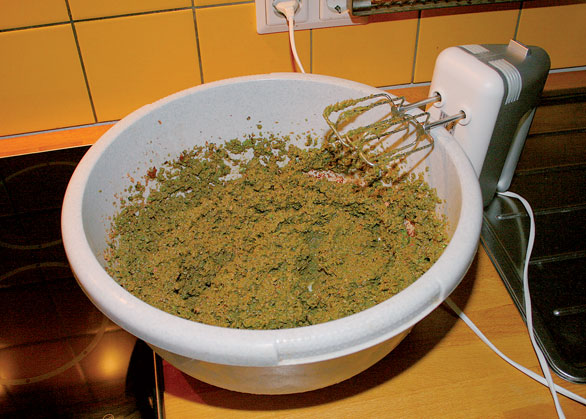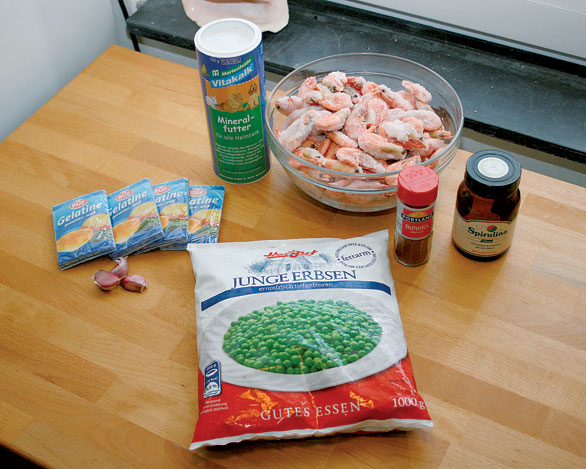
We have purchased all the ingredients; let’s start cooking! (Frozen green peas, table shrimp, Spirulina powder, gelatin powder, liquid multivitamin.)
Making Tropheus food at home
Article and images by Norbert Knaak • AMAZONAS Web Bonus Article
Probably no other topic is as controversial among aquarists as the well-being of our fishes—and especially their nutrition. As with most aspects of our hobby, there is a wide range of solutions. Some people spend impressive sums to purchase their fishes, but then settle for going online and ordering some generic fish food neatly packed in plastic bags. At the other end of the spectrum are the aquarists who get out of bed before dawn on a Sunday morning to drag their nets through ponds, often bypassing local laws to collect pond food to feed to the hungry fishes at home.
Although I do not consider myself part of the second group, I fall somewhere in between. My difficulty is that I keep species with widely different nutritional requirements—from L-catfish to Lake Malawi cichlids to the bull class from Lake Tanganyika, including Cyphotilapia frontosa and Lobochilotes labiatus.
In 1993, I was lucky enough to run across what I considered the best book about keeping cichlids. With that book, Enjoying Cichlids (Cichlid Press), Ad Konings handed many aquarists a roadmap that has made life and survival easier for many fishes. The subject of nutrition naturally received the necessary consideration, and one passage in particular drew my attention: a recipe for homemade “shrimp mix.”
Konings came up with the idea for this food after observing that the very colorful appearance of cichlids in the wild tended to become washed out over time in captivity. He designed a series of experiments in which a number of Red Zebras (Maylandia estherae) were divided into different groups. Each group was fed over a period of five weeks with a different feed. The two groups that received food containing shrimps and Spirulina powder had by far the most intense colors. Since I have already revealed the two main ingredients of the mixture, I should probably spill the whole recipe:
Shrimp Mix
Konings’ Original Recipe
2.2 lb. (1 kg) frozen whole shrimps, unpeeled
2.2 lb. (1 kg) frozen green peas
0.3 oz. (10 ml) Spirulina powder
3.5 oz. (100 g) gelatin powder
10 drops vitamin concentrate
Enhancement Options
2 Tablespoons Sweet Paprika
2-3 Cloves Garlic
1 lb. Quality Fish Food (pellets or flakes)
I modified this basic recipe by replacing the Spirulina powder with Chlorella algae powder (which in the picture is stored in a Spirulina jar). I left out the vitamins, but added 2–3 tablespoons of a calcium-vitamin premix for animals, 2 tablespoons of sweet paprika powder, and 2–3 cloves of garlic, since critics claim that, except for chocolate pudding, all of my meals contain garlic. To make all the effort worthwhile, I also add about 1 quart (1 L) of granulated quality fish food. [Editor: In the November/December 2013 issue of AMAZONAS, Tropheus breeder Mattias Eberhardt reveals that he uses this basic recipe, but doubles the amount of peas.]
In addition to its balanced composition, the biggest advantage of this food is that all fishes really like it and, even more important, tolerate it well—including Tropheus!
I have seen over the years that sensitive Tropheini, Cyprichromini, tetras of all kinds, catfishes, and others that have been fed this mixture show good growth, vitality, and fertility, proving that the food is a good one. Another advantage is that both the smallest juveniles (simply scrape the frozen food with a spoon) and the aforementioned bull class (be careful—they might try to eat the spoon!) can be served the same thing.
One important point: you should definitely thaw the food completely before feeding! The risk of turbid water is small, thanks to the binder.
Have I whetted your appetite? Go ahead and try it—and, my dear fellows, don’t forget that cleaning up is part of the process.
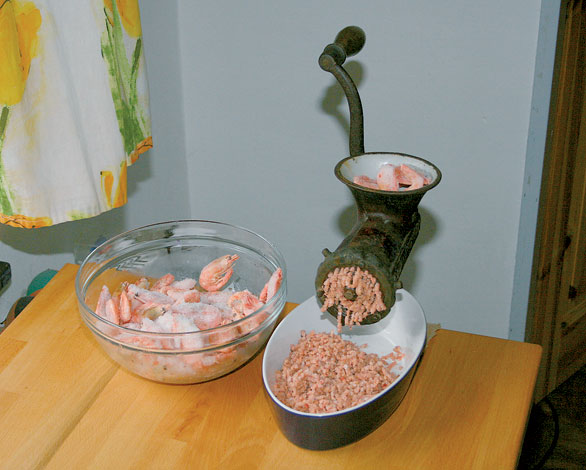
First, everything is churned through the meat grinder; the shrimps are fully cooked and processed with the shell! Do no use fresh Mysis or similar, otherwise the binder does not work.
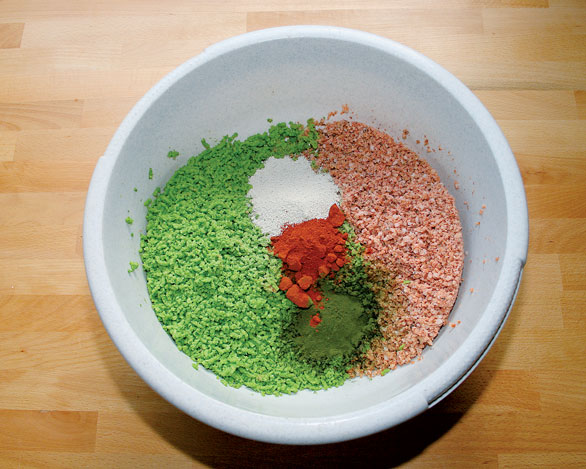
Because we process both peas and shrimps in the frozen state, the material is left to thaw in a suitable space (beware of pets or put in the fridge!) and then supplemented with the “spices” (dry ingredients).
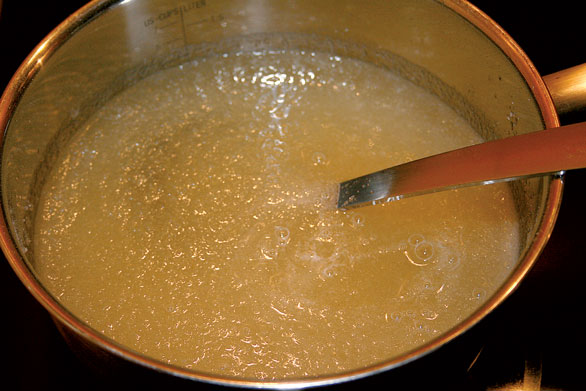
I use 108 g of gelatin (there are 9 g in a package hence the “odd” number) which are dissolved in 1 L of boiling water. Now, we are approaching the only phase of our cooking class where time counts.
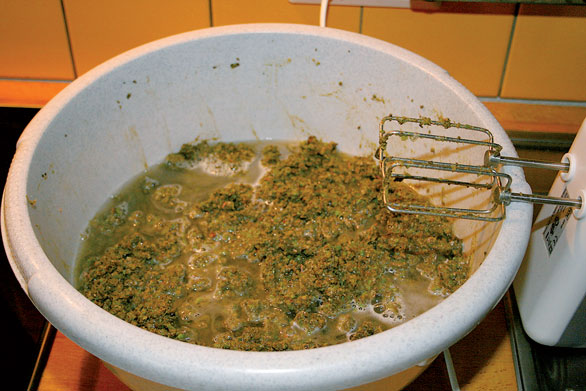
The dissolved gelatin is added to our food mixture and carefully blended in. The resulting mash is then poured quickly on a baking sheet to solidify.
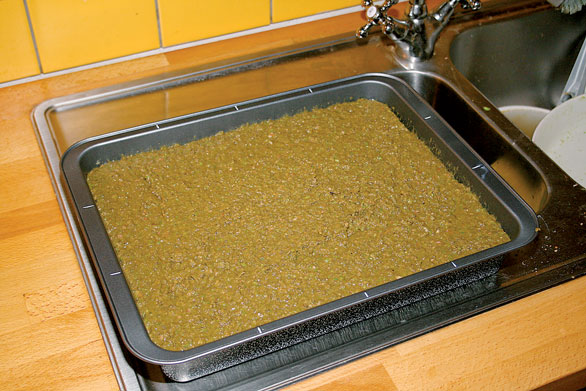
The experienced food cook marks the baking sheet, so that after setting we can cut equally large pieces.
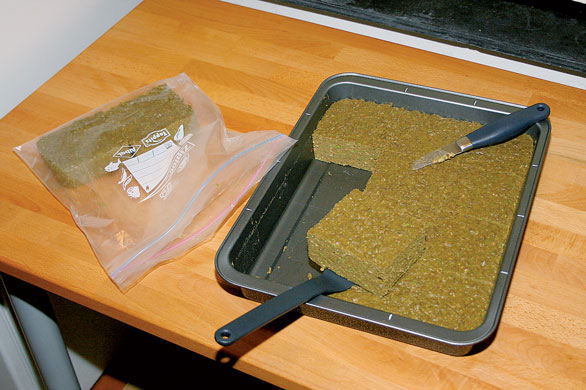
The portions are cut to sizes you want to use. This square weighs about 260 g (9 oz), equal to the amount that I use in one feeding. These are packaged and frozen for later consumption.

